|
|
|
 |
|
|
|
|
|
|
|
(Lower) South Street
|
|
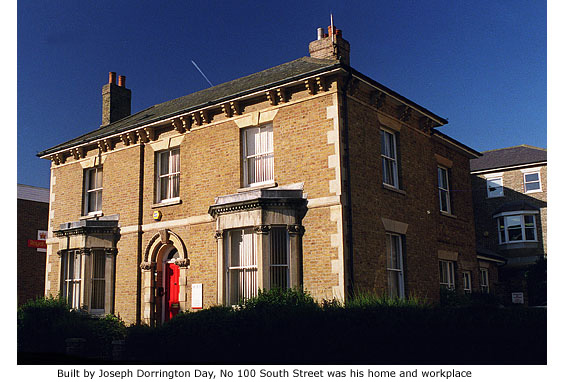
The elegant detached Georgian building (No 100) that stands alongside the post office is now used for business purposes, but was once the home of *Joseph Dorrington Day, stonemason, builder and brick maker who, needless to say, built it.
* Joseph Dorrington Day: born 2 December 1858, died 3 July 1937
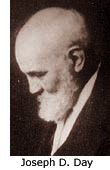 Mr Day was also a strong temperance man who regularly arranged Sunday School outings for local children, and it was he who, in 1910, discovered the remains of an Iron Age horse while preparing foundations for a house in Maple Avenue (See Guide 5). Mr Day was also a strong temperance man who regularly arranged Sunday School outings for local children, and it was he who, in 1910, discovered the remains of an Iron Age horse while preparing foundations for a house in Maple Avenue (See Guide 5).
His daughter, Daisy Day, achieved great renown as a portrait photographer in the 1920s and was one of the first women to achieve the much coveted Fellowship of the Royal Photographic Society (FRPS). Although not keen on her chosen career, Mr Day built her a photographic studio within the house.
|
|
Swans have been a feature of English waterways for centuries, and the river Stort has always supported nesting swans. Under a ruling by King Edgar in 966, the rights to all stray swans were given to Crowland Abbey in Lincolnshire, but when Henry VIII dissolved the monasteries in the 16th century, those rights passed to the Crown.
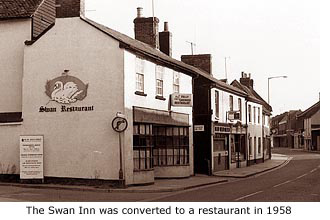 Bishop’s Stortford inns have borne testimony to their presence here for centuries, the Swan Inn in the High Street (then Wheathill) being the first to carry the name in the 16th century. In the 17th century the Half Moon Inn at North Street was first called the Swan, and here in South Street the Blue Boar Inn became the White Swan in 1684, although it was later renamed the Swan. Bishop’s Stortford inns have borne testimony to their presence here for centuries, the Swan Inn in the High Street (then Wheathill) being the first to carry the name in the 16th century. In the 17th century the Half Moon Inn at North Street was first called the Swan, and here in South Street the Blue Boar Inn became the White Swan in 1684, although it was later renamed the Swan.
In the early 18th century this same inn was the starting point for an express stagecoach service called The ‘Flying Machine’, travelling to London three times a week and covering the distance in about four hours. The arrival of the railway eventually put an end to the service but by the early 1900s the Swan once again became popular as a stop-over for cyclists. It ceased to be an inn altogether in 1958, becoming the Swan Restaurant soon after.
|
|
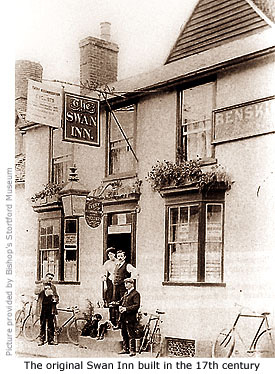 On 18 March 1960 it also became home to the Cygnet Jazz Club, but its popularity was secondary to the successful Mitre Jazz Club and lasted only a year. Finally, in the 1980s, the premises became a Chinese restaurant. The building’s frontage at ground floor level has since been radically altered, but much of the original timber cladding at the side and rear is still in evidence. On 18 March 1960 it also became home to the Cygnet Jazz Club, but its popularity was secondary to the successful Mitre Jazz Club and lasted only a year. Finally, in the 1980s, the premises became a Chinese restaurant. The building’s frontage at ground floor level has since been radically altered, but much of the original timber cladding at the side and rear is still in evidence.
Between Swan Court and Newtown Road stand four small buildings from different periods of the 19th century. Number 84 had a new shop frontage added in 1899 and in the 1970s became a secondary branch of North Street’s Midland Bank (now HSBC). Cost cutting forced its closure in the early 1980s.
Number 82 currently has ‘The Kings Arms Centre’ emblazoned across its frontage, and as the name suggests was once the Kings Arms public house dating from the late 19th century. Long before that it was a private home that became a beerhouse called the Kingsway Arms, the name perhaps originating from the fact that in the 17th century Charles II often passed through South Street en route to Newmarket. It was occupied in 1867 by W.B. Copping and owned by brewers EK & O Fordham. After closure of the more recent pub in 1969 the premises was used as a youth centre and subsequently a shop.
|
|
|
|
The Bridge House
|
|
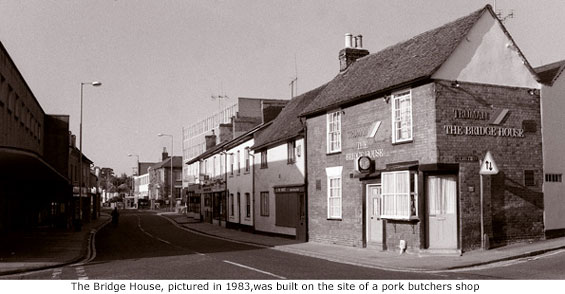 |
|
|
|
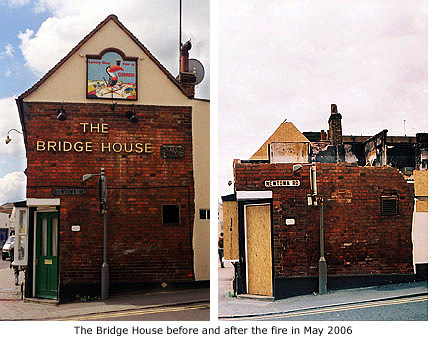 The building of a bridge across the river Stort at this end of town in 1866, inevitably led to the construction of a pub two years later named, rather obviously, the Bridge Beer House. The building of a bridge across the river Stort at this end of town in 1866, inevitably led to the construction of a pub two years later named, rather obviously, the Bridge Beer House.
Built on the site of a pork butchers shop, it was first served by local maltsters, Flinn's, and held for many years by the Mullen family. In the 1880s this was also the lodging house of Louis H. Fehrenbach and his three nephews; all clock and watchmakers originally from St Margen in Freiburg, Germany. SEE BELOW
Later renamed the Bridge House, Truman’s Brewery took it over in 1937. They finally got round to modernising the interior in 1968, but not until the turn of the 21st century was central heating installed. Prior to this, regulars referred to it as the ‘Fridge House’. The pub's name has always been displayed on the building, but for some reason it has remained the only pub in Bishop's Stortford never to have carried a traditional pub sign.
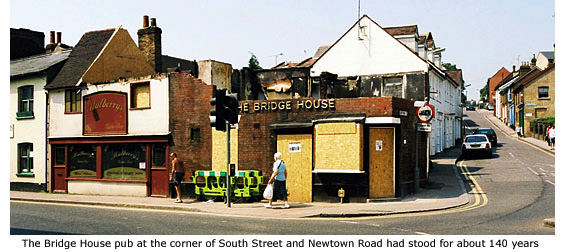
In the early hours of Wednesday 17 May 2006 The Bridge House was destroyed by a fire thought to have been started by an electrical fault. Nobody was injured, but it did take 30 firefighters two and a half hours to extinguish the blaze that also seriously damaged the upstairs of the adjoining building. So badly damaged was the listed Bridge House that demolition and a complete rebuild proved the only answer to its survival on this site.
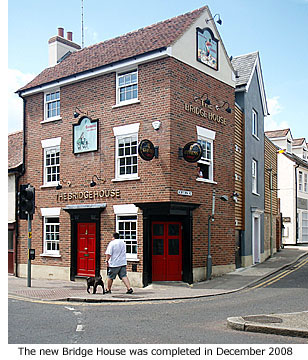 To this end, work began in 2007 and finished in December 2008 to reveal a completely rebuilt pub. One story higher than the original its design is a pleasing mix of modern and traditional, adding some much needed character to this part of the town. To this end, work began in 2007 and finished in December 2008 to reveal a completely rebuilt pub. One story higher than the original its design is a pleasing mix of modern and traditional, adding some much needed character to this part of the town.
The ground floor layout remains exactly the same as it was before and most of the original signs that survived the fire have been put back up.
An additional entrance in Newtown Road opens on to a staircase that leads to a second floor area. The Grand opening of this part took place on Friday 19 December, one week after the pub reopened its downstairs area to the public.
|
|
|
|
The Fehrenbach Family
|
|
London was the premier watchmaking centre of the world in the 19th century, attracting countless craftsmen from Europe in search of work. But with job opportunities limited by their sheer number, many moved on to establish their own businesses in the towns and cities of Britain. This may well have been the reason for the arrival in Bishop's Stortford, in the 1850s, of three brothers named Fehrenbach.
Their family were farmers in St Margen in the Black Forest region of Germany, but with meagre rewards from their labour, especially in winter-time, the menfolk supplemented their income by working for local clock and watchmakers. With the skills they learned, the younger men eventually abandoned farming altogether and came to England.
The brothers were: Lambert (b.1826), Herkulan, (also known as Hercules or Louis H, b.1828), and Berthold (b.1830). Working together and sometimes individually, all three were listed in Kelly's trade directories as clock and watchmakers in Bishop's Stortford between 1859 and 1884. In 1880 'Fehrenbach & Co' is listed as being in South Street.
The 1881 census shows the unmarried Louis H (Herkulan or Hercules) living at the Bridge beer house in South Street with his nephews, John (Johannes), Andrew (Andreas), and Joseph Fehrenbach. Also watchmakers, they were the sons of his father's brother.
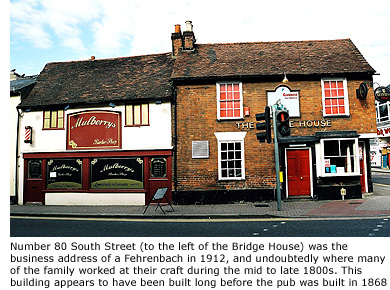 Of these, Joseph (b.1846) ran a business in South Street from 1871 to 1881, and at a later date so did Andrew (b.1863) with another brother named Lucas (b.1866). Lucas is also recorded as being in business at 80 South Street in 1912, but eventually returned to St Margen where he died in 1926.
Of these, Joseph (b.1846) ran a business in South Street from 1871 to 1881, and at a later date so did Andrew (b.1863) with another brother named Lucas (b.1866). Lucas is also recorded as being in business at 80 South Street in 1912, but eventually returned to St Margen where he died in 1926.
Number 80 South Street still stands next to the Bridge House Pub. This 'numbered' address appears just once (1912) in trade directories listing the Fehrenbachs, but was probably the premises most often used by all family members when carrying out their work.
|
|
The most prominent and long-standing member of this family was John (b.1847), who had his own business at Potter Street from 1890. A Catholic, he married a local Protestant girl named Ellen Farmer and between them they had four children. He was one of only a handful of Catholics in the town at that time, but after the arrival of the Sisters of St Mary of Namur in 1896 (to start a convent and school here) the congregation grew rapidly. In 1900 John was instrumental in establishing the first Catholic church in the town since the Reformation, a fact that, until now, was little known (See Guide 4 – St Joseph's Church).
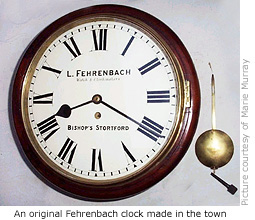 John Fehrenbach eventually gave up the business in Potter Street and worked from his home at 30 Portland Road. He died in 1917, aged 70, and was buried in New Cemetery, Apton Road. His son, John Maxilillian, married Eleanor May Russell and they had two daughters, Joan and Marie. Joan married into a long-standing Bishop's Stortford family named Bush. John Maximillian Fehrenbach carried on in the watchmaking trade working for Ingersoll and Rotary in London, and in World War I fought in France with the Middx Regiment.
John Fehrenbach eventually gave up the business in Potter Street and worked from his home at 30 Portland Road. He died in 1917, aged 70, and was buried in New Cemetery, Apton Road. His son, John Maxilillian, married Eleanor May Russell and they had two daughters, Joan and Marie. Joan married into a long-standing Bishop's Stortford family named Bush. John Maximillian Fehrenbach carried on in the watchmaking trade working for Ingersoll and Rotary in London, and in World War I fought in France with the Middx Regiment.
*This detailed information about the Fehrenbach family is courtesy of Marie Murray, grandaughter of John Maximillian Fehrenbach, and great grandaughter of John (Johannes) Fehrennbach.
|
|
|
|
[ BACK TO TOP ] |
|
|
|
|
|
|
|
|
|





 Mr Day was also a strong temperance man who regularly arranged Sunday School outings for local children, and it was he who, in 1910, discovered the remains of an Iron Age horse while preparing foundations for a house in Maple Avenue (See Guide 5).
Mr Day was also a strong temperance man who regularly arranged Sunday School outings for local children, and it was he who, in 1910, discovered the remains of an Iron Age horse while preparing foundations for a house in Maple Avenue (See Guide 5). Bishop’s Stortford inns have borne testimony to their presence here for centuries, the Swan Inn in the High Street (then Wheathill) being the first to carry the name in the 16th century. In the 17th century the Half Moon Inn at North Street was first called the Swan, and here in South Street the Blue Boar Inn became the White Swan in 1684, although it was later renamed the Swan.
Bishop’s Stortford inns have borne testimony to their presence here for centuries, the Swan Inn in the High Street (then Wheathill) being the first to carry the name in the 16th century. In the 17th century the Half Moon Inn at North Street was first called the Swan, and here in South Street the Blue Boar Inn became the White Swan in 1684, although it was later renamed the Swan. On 18 March 1960 it also became home to the Cygnet Jazz Club, but its popularity was secondary to the successful Mitre Jazz Club and lasted only a year. Finally, in the 1980s, the premises became a Chinese restaurant. The building’s frontage at ground floor level has since been radically altered, but much of the original timber cladding at the side and rear is still in evidence.
On 18 March 1960 it also became home to the Cygnet Jazz Club, but its popularity was secondary to the successful Mitre Jazz Club and lasted only a year. Finally, in the 1980s, the premises became a Chinese restaurant. The building’s frontage at ground floor level has since been radically altered, but much of the original timber cladding at the side and rear is still in evidence. The building of a bridge across the river Stort at this end of town in 1866, inevitably led to the construction of a pub two years later named, rather obviously, the Bridge Beer House.
The building of a bridge across the river Stort at this end of town in 1866, inevitably led to the construction of a pub two years later named, rather obviously, the Bridge Beer House.
 To this end, work began in 2007 and finished in December 2008 to reveal a completely rebuilt pub. One story higher than the original its design is a pleasing mix of modern and traditional, adding some much needed character to this part of the town.
To this end, work began in 2007 and finished in December 2008 to reveal a completely rebuilt pub. One story higher than the original its design is a pleasing mix of modern and traditional, adding some much needed character to this part of the town. Of these, Joseph (b.1846) ran a business in South Street from 1871 to 1881, and at a later date so did Andrew (b.1863) with another brother named Lucas (b.1866). Lucas is also recorded as being in business at 80 South Street in 1912, but eventually returned to St Margen where he died in 1926.
Of these, Joseph (b.1846) ran a business in South Street from 1871 to 1881, and at a later date so did Andrew (b.1863) with another brother named Lucas (b.1866). Lucas is also recorded as being in business at 80 South Street in 1912, but eventually returned to St Margen where he died in 1926. John Fehrenbach eventually gave up the business in Potter Street and worked from his home at 30 Portland Road. He died in 1917, aged 70, and was buried in New Cemetery, Apton Road. His son, John Maxilillian, married Eleanor May Russell and they had two daughters, Joan and Marie. Joan married into a long-standing Bishop's Stortford family named Bush. John Maximillian Fehrenbach carried on in the watchmaking trade working for Ingersoll and Rotary in London, and in World War I fought in France with the Middx Regiment.
John Fehrenbach eventually gave up the business in Potter Street and worked from his home at 30 Portland Road. He died in 1917, aged 70, and was buried in New Cemetery, Apton Road. His son, John Maxilillian, married Eleanor May Russell and they had two daughters, Joan and Marie. Joan married into a long-standing Bishop's Stortford family named Bush. John Maximillian Fehrenbach carried on in the watchmaking trade working for Ingersoll and Rotary in London, and in World War I fought in France with the Middx Regiment.